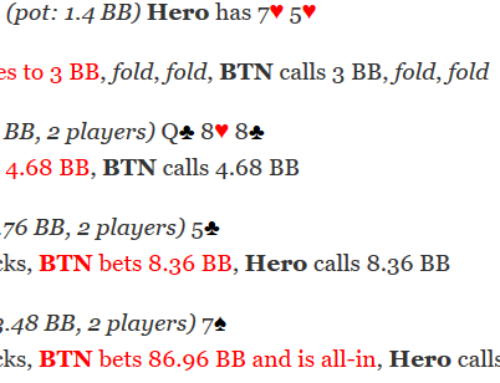I was playing 100nl on Bovada today and saw a bad bluff by a regular. I’m pretty sure in his mind he probably thought it was a decent to good bluff, but I wanted to break down the mistakes he made and what they were since I’ve seen them happen a lot.
So the action folds to me on the button with Jc 8d and I open to 3x. I used to open to 2.5x sometimes, but I open 3 – 4x now on the button because, well. more people are calling in the blinds then they used to and I like more money. 🙂
The SB folds and the BB calls. The flop comes – 4c Js 8h
I bet 3/4 pot and my opponent calls. The turn comes – As.
My opponent checks, and I bet 3/4 again. I’m still getting a ton of calls from Jx, maybe even 8x and straight draws like 9T as well as hands that decided to c/c like AT. So my opponent takes a little while and then check raises. I’m never loving a check raise, but I’m clearly calling. AJ doesn’t make a ton of sense for him to have, but he could have A4/A8 or a set of 44/88’s. Unlikely of course, but I’m never consider folding here.
The river comes a brick. I believe it was 3x. It doesn’t matter. My opponent bet about 2/3rd, which I think was $40, and I called. He has 57o.
Now, the Ace of course is a standard scare card. It’s not a bad card to bluff in a situation that makes sense. Not a ton makes too much sense here really. If he was super strong with 44/88, he’d be better of just calling the turn and then bombing the river himself (well, not full bomb, but maybe 3/4+ size bet). I’ll call with strong Ax and two pairs all day, but I could fold most Ax to a CR on the turn. AJ doesn’t make too much sense for him to A) have in his range because he probably only flats about 1/2 the time or less and 3-bets a decent % of the time pre-flop, and if he did have AJ, all of the reasonable second best combos for me to have are slightly reduced by his AJ. So, just a lot of things don’t really make sense.
It looks much more like he has a straight of flush draw, either on the flop (straight draw) or turned (flush), and wants to blow me off my weak hand – which it will be in most cases. Both of those factors together- my perceived range being weak, and the CR on the A turn start to create the anatomy of a bad bluff. You need to consider what your opponent will likely know that you know about their range, and how strong it can be, and you need to consider that if you had a strong hand in that spot, what hands are you looking for people to call?
The second and most important part of an anatomy of a bad bluff is on boards that don’t have a ton of draws, if you do make a move on the turn by check raising, and your opponent calls a turn check raise, the likelihood of success on a follow through is pretty small. I think this is especially true at small and micro stakes where the absolute dollar amounts in play are not very much. People are more apt to call when it’s not going to break them. So if you make a play on the turn, especially something as strong as a check raise and you’re called, then it’s probably time to shut it down. Unless you know your opponent like to just call with draws, and/or just makes poor river decisions.
So just make sure you’re really thinking through your bluffs. Successful bluffs need to have all of the elements of a good story aligned, and you need to know when not to follow through as well.



Leave A Comment
You must be logged in to post a comment.